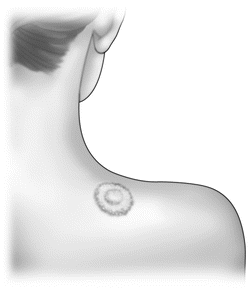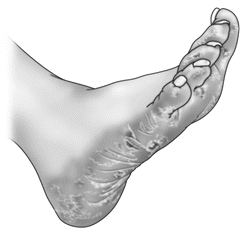, Toral Patel3, 4, Neill T. Peters3, 2 and Sarah Kasprowicz5
(1)
Northwestern University Feinberg School of Medicine, Chicago, IL, USA
(2)
Medical Dermatology Associates of Chicago, Chicago, IL, USA
(3)
Instructor of Clinical Dermatology, Northwestern University Feinberg School of Medicine, Chicago, IL, USA
(4)
D&A Dermatology, Chicago, IL, USA
(5)
NorthShore University HealthSystem, University of Chicago, Pritzker School of Medicine, Chicago, IL, USA
Keywords
Bacterial infectionsFungal infectionsNail infectionsTea tree oilCoriander oilOil of bitter orangeSolan chrysotrichumGarlicArgeratina pichinchensisHoneyIntroduction to Fungi
Cutaneous fungal infections can be classified into infections that are limited to the stratum corneum, hair and nails and, infections that are seen deeper in the skin, involving the dermis and the subcutaneous tissues. Superficial mycoses include: tinea versicolor, tinea nigra, pityrosporum folliculitis, tinea corporis, tinea cruris, tinea barbae, tinea capitis, tinea pedis, and tinea unguium. Numerous genera are responsible for superficial mycoses including, but not limited to: Malassezia, Trichophyton, Microsporum and Epidermophyton. Diagnosis and treatment of these infections can pose a challenge. Topical antifungals may be ineffective if the organism exhibits resistance to the antifungal agent. Additionally, the topical antifungals themselves can cause allergic and irritant skin reactions. Oral agents are sometimes used when topical agents are not helpful and these agents are associated with a high incidence of systemic side effects. Many patients seek “alternative” approaches to traditional therapy to avoid these potential side effects. Worldwide, many plants are used to treat various bacterial and fungal infections. While some have been looked at in vitro, a minuscule percentage of these plants have been subjected to controlled clinical trials (Martin and Ernst 2004). Here we present primary and secondary considerations for treatment of fungal infections with plant derivatives, though it must be emphasized that much of the evidence in this section is fairly thin.
Clinical Considerations for Fungi
Top Considerations for Fungal Infections
See Tables 13.1 and 13.2.
Table 13.1.
Top considerations for fungal infections.
Treatment | How administered | Notes |
|---|---|---|
Tea tree oil | Topically to the affected areas | High rate of contact and irritant dermatitis |
Table 13.2.
Secondary considerations for fungal infections.
Treatment | How administered | Notes |
|---|---|---|
Coriander oil | A 6% concentration in a wax-like base, topically | Good tolerability; Difficult to replicate vehicle used in study |
Oil of bitter orange | Concentrations from 20% to 100%, topically | Mild irritation noted |
Solanum chrysotrichum | Various regimens of Solanum chrysotrichum application, topically | May be difficult to source |
Garlic (ajoene) | Ajoene extract applied topically | Difficult to extract ajoene from garlic, difficult to source |
Ageratina pichinchensis | Extract applied topically | May be difficult to source |
Topical Tea Tree Oil
Tea tree oil is an essential oil from the leaves of the Australian native tree, Melaleuca alternifolia. The indigenous people of Australia have used tea tree oil from crushed leaves as a traditional remedy for coughs and colds as well as to treat wounds and skin infections. Tea tree oil is commonly used as a topical antimicrobial agent. There have been a number of papers describing the antiseptic properties of tea tree oil, which has potential antibacterial activity through disruption of bacterial membranes (Carson et al. 2006). It is important to counsel patients that tea tree oil can be very irritating and a source of allergic contact dermatitis (Knight and Hausen 1994). Tea tree oil has been shown to have activity against dermatophytes in vitro (Hammer et al. 2002).
Evidence for Topical Tea Tree Oil
1.
Treatment of interdigital tinea pedis with 25% and 50% tea tree oil solution: a randomized, placebo controlled, blinded study. Satchell AC, Saurajen A, Bell C, Barnestson RS. Austalas J Dermatol. 2002 Aug;43(3):175–8.
This randomized, controlled, double-blinded study looked at the efficacy and safety of 25% and 50% tea tree oil in the treatment of interdigital tinea pedis. One hundred and fifty-eight patients with tinea pedis clinically and microscopically diagnostic of a dermatophyte infection were randomized to receive either a placebo, 25% or 50% tea tree oil solution. Patients applied the solution twice daily to affected areas for 4 weeks and were reviewed after 2 and 4 weeks of treatment. Clinical response was seen in 68% of the half-strength tea tree oil group and 72% of the quarter-strength tea tree oil group compared to 39% in the placebo group. Culture of skin scrapings also showed a mycological cure rate of 64% in the half-strength tea tree oil group compared to 31% in the placebo group. Of note, 3.8% of the patients did develop a moderate to severe contact dermatitis from the tea tree oil.
2.
Comparison of two topical preparations for the treatment of onychomycosis: Melaleuca alternifolia (tea tree) oil and clotrimazole. Buck DS, Nidorf DM, Addino JG. J Fam Pract. 1994 Jun;38(6):601–5.
A double-blind, multicenter, randomized controlled trial was conducted. One hundred and seventeen patients were looked at with distal subungual onychomycosis, proven by culture. Patients received twice-daily application of either 1% clotrimazole (CL) solution or 100% tea tree (TT) oil for 6 months.
Debridement and clinical assessment were performed at 0, 1, 3 and 6 months. Cultures were obtained at 0 and 6 months. After 6 months of therapy, the two treatment groups were comparable based on culture cure (CL = 11%, TT = 18%) and clinical assessment documenting partial or full resolution (CL = 61%, TT = 60%). They concluded that the use of topical tea tree oil preparation in conjunction with debridement of the nail was a useful clinical strategy.
Secondary Considerations
Coriander Oil
Coriander (Coriander sativum) is an annual herb in the family Apiaceae. Although coriander is the seed of the cilantro (Chinese parsley) plant, their flavors and properties are very different and they cannot be substituted for each other. Coriander has both culinary and medicinal applications. It is common in South Asian, Southeast Asian, Middle Eastern and Latin American cuisine, to name only a few. In addition to culinary uses, coriander has been touted as having many medicinal and pharmacological applications including: anti-microbial, anti-oxidant and anti-inflammatory properties (Sahib et al. 2013). Essential coriander oil has shown antibacterial activity towards many bacterial strains including Streptococcus pyogenes, and methicillin-resistant Staphylococcus aureus (MRSA) in vitro (Casett et al. 2012). In addition, in vitro studies also indicate that coriander essential oil shows promise in eradicating Candida (Freires et al. 2014).
Evidence for Coriander Oil
1.
Topical treatment of tinea pedis using 6% coriander oil in unguentum leniens: a randomized, controlled, comparative pilot study. Beikert FC, Anastasiadou Z, Fritzen B, Frank U, Augustin M. Dermatology. 2013; 226(1):47–51.
This study evaluated the efficacy and tolerability of 6% coriander oil in ungeuentum leniens (a wax base) in the treatment of interdigital tinea pedis. This was a half-side comparative pilot study on subjects with symmetric, bilateral interdigial tinea pedis. Active drug and placebo control were applied twice daily on the affected areas, and follow up visits were performed on days 14 and 28. Forty participants were included in the study. A highly significant improvement in the clinical signs (p < 0.0001) was observed during the entire observation period; the number of fungal cultures also tended to decrease (p = 0.0654). It was concluded that coriander oil in this wax base was effective and well tolerated in the treatment of interdigital tinea pedis.
Oil of Bitter Orange
The bitter orange (Citrus aurantium) is native to Southeast Asia. During the 10th and 11th centuries traders introduced the plant to the Mediterranean and the Spanish and the Portuguese brought the plant to the Americas in the fifteenth century. Globally it is widely cultivated. The bitter orange is an evergreen tree that can grow up to 10 m with long spines and very fragrant flowers. The entire plant is used for various purposes from culinary to medicinal to body care. From the flowers comes Neroli oil which is a popular oil used in fragrances. From the leaves and twigs comes Petitgrain essential oil, also used in aromatherapy and perfumery (DerMarderosian and Beutler 2012). The extracts from the plant have been looked at for their potential anti-inflammatory, antibacterial, anti-cholesterol and antifungal properties. Neroli oil, extracted from blossoms of the bitter orange tree has been shown, in vitro, to have antibacterial activity against Pseudomonas aeruginosa as well as strong antifungal activity when compared to Nystatin (Ammar et al. 2012).
Evidence for Oil of Bitter Orange
1.
Oil of bitter orange: a new topical antifungal agent. Ramadan W, Mourad B, Ibrahim S, Sonobol F. Int J Dermatol. 1996 Jun; 35(6):448–9.
Sixty patients were classified into three groups of 20 patients each. All groups had comparable numbers of patients with tinea corporis, tinea cruris and tinea pedis. Group 1 was treated with a 25% emulsion of oil of bitter orange (OBO) three times daily. Group 2 was treated with 20% OBO in alcohol three times daily. And, Group 3 was treated with pure OBO, once daily. Clinical and mycological examinations were performed before therapy and every week until a complete cure had occurred. In Group 1, 80% of patients were cured in 1–2 weeks and 20% in 2–3 weeks. In Group 2, 50% were cured in 1–2 weeks, 30% in 2–3 weeks, and 20% in 3–4 weeks. In Group 3, 25% of patients did not continue the trial. The authors note mild irritation was seen with the oil but oil of bitter orange showed promise in exerting fungistatic and fungicidal activity.
Solanum chrysotrichum
Stay updated, free articles. Join our Telegram channel

Full access? Get Clinical Tree










